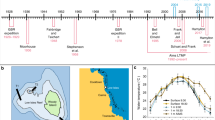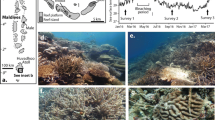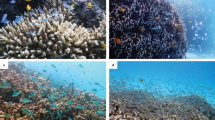Abstract
The dynamic nature of coral reefs offers a rare opportunity to examine the response of ecosystems to disruption due to climate change. In 1998, the Great Barrier Reef experienced widespread coral bleaching and mortality. As a result, cryptobenthic fish assemblages underwent a dramatic phase-shift. Thirteen years, and up to 96 fish generations later, the cryptobenthic fish assemblage has not returned to its pre-bleach configuration. This is despite coral abundances returning to, or exceeding, pre-bleach values. The post-bleach fish assemblage exhibits no evidence of recovery. If these short-lived fish species are a model for their longer-lived counterparts, they suggest that (1) the full effects of the 1998 bleaching event on long-lived fish populations have yet to be seen, (2) it may take decades, or more, before recovery or regeneration of these long-lived species will begin, and (3) fish assemblages may not recover to their previous composition despite the return of corals.




Similar content being viewed by others
References
Ackerman JL, Bellwood DR (2000) Reef fish assemblages: a re-evaluation using enclosed rotenone stations. Mar Ecol Prog Ser 206:227–237. doi:10.3354/meps206227
Ackerman JL, Bellwood DR (2002) Comparative efficiency of clove oil and rotenone for sampling tropical reef fish assemblages. J Fish Biol 60:893–901. doi:10.1111/j.1095-8649.2002.tb02416.x
Ackerman JL, Bellwood DR, Brown JH (2004) The contribution of small individuals to density-body size relationships: examination of energetic equivalence in reef fishes. Oecologia 139:568–571. doi:10.1007/s00442-004-1536-0
Anthony KRN, Kerswell AP (2007) Coral mortality following extreme low tides and high solar radiation. Mar Biol 151:1623–1631
Atema J, Kingsford MJ, Gerlach G (2002) Larval reef fish could use odour for detection, retention and orientation to reefs. Mar Ecol Prog Ser 241:151–160. doi:10.3354/meps241151
Baird AH, Marshall PA (2002) Mortality, growth and reproduction in scleractinian corals following bleaching on the Great Barrier Reef. Mar Ecol Prog Ser 237:133–141. doi:10.3354/meps237133
Bellwood DR, Hughes TP, Folke C, Nyström M (2004) Confronting the coral reef crisis. Nature 429:827–833. doi:10.1038/nature02691
Bellwood DR, Hoey AS, Ackerman JL, Depczynski M (2006) Coral bleaching, reef fish community phase shifts and the resilience of coral reefs. Glob Change Biol 12:1587–1594. doi:10.1111/j.1365-2486.2006.01204.x
Berkelmans R, De’ath G, Kininmonth S, Skirving WJ (2004) A comparison of the 1998 and 2002 coral bleaching events on the Great Barrier Reef: spatial correlation, patterns, and predictions. Coral Reefs 23:74–83. doi:10.1007/s00338-003-0353-y
Berumen ML, Pratchett MS (2006) Recovery without resilience: persistent disturbance and long-term shifts in the structure of fish and coral communities at Tiahura Reef, Moorea. Coral Reefs 25:647–653. doi:10.1007/s00338-006-0145-2
Cheal AJ, Wilson SK, Emslie MJ, Dolman AM, Sweatman H (2008) Responses of reef fish communities to coral declines on the Great Barrier Reef. Mar Ecol Prog Ser 372:211–223. doi:10.3354/meps07708
Clarke KR, Warwick RM (1994) Similarity-based testing for community pattern—the 2-way layout with no replication. Mar Biol 118:167–176. doi:10.1007/BF00699231
Depczynski M, Bellwood DR (2003) The role of cryptobenthic reef fishes in coral reef trophodynamics. Mar Ecol Prog Ser 256:183–191. doi:10.3354/meps256183
Depczynski M, Bellwood DR (2004) Microhabitat utilization patterns in cryptobenthic reef fish communities. Mar Biol 145:455–463. doi:10.1007/s002270004-1342-6
Depczynski M, Bellwood DR (2005) Shortest recorded vertebrate lifespan found in a coral reef fish. Curr Biol 15:288–289. doi:10.1016/j.cub.2005.04.016
Depczynski M, Bellwood DR (2006) Extremes, plasticity, and invariance in vertebrate life history traits: insights from coral reef fishes. Ecology 87:3119–3127. doi:10.1890/0012-9658(2006)87[3119:EPAIIV]20CO2
Depczynski M, Fulton CJ, Marnane MJ, Bellwood DR (2007) Life history patterns shape energy allocation among fishes on coral reefs. Oecologia 153:111–120. doi:10.1007/s00442-007-0714-2
Diaz-Pulido G, McCook LJ, Dove S, Berkelmans R, Roff G, Kline DI, Weeks S, Evans RD, Williamson DH, Hoegh-Guldberg O (2009) Doom and boom on a resilient reef: climate change, algal overgrowth and coral recovery. PLoS ONE 4:e5239 1–9 doi:10.1371/journal.pone.0005239
Dixson DL, Jones GP, Munday PL, Planes S, Pratchett MS, Srinivasan M, Syms C, Thorrold SR (2008) Coral reef fish smell leaves to find island homes. Proc R Soc Lond B 275:2831–2839. doi:10.1098/rspb.2008.0876
Farnsworth CA, Bellwood DR, van Herwereden L (2010) Genetic structure across the GBR: evidence from short-lived gobies. Mar Biol 157:945–953. doi:10.1007/s00227-009-1375-y
Fox RJ, Bellwood DR (2007) Quantifying herbivory across a coral reef depth gradient. Mar Ecol Prog Ser 339(49):59. doi:10.3354/meps339049
Herler J (2007) Microhabitats and ecomorphology of coral- and coral rock-associated gobiid fish (Teleostei: Gobiidae) in the northern Red Sea. Mar Ecol 28:82–94. doi:10.3354/meps342265
Herler J, Munday PL, Hernaman V (2011) Gobies on coral reefs.In: Patzner RA, Van Tassel JL, Kovačić, Kapoor BG (eds) The biology of gobies. Science Publishers, St.Helier, pp 493–529
Hernaman V, Munday PL (2005) Life history characteristics of coral reef gobies: I. Growth and life-span. Mar Ecol Prog Ser 290:207–211. doi:10.3354/meps290207
Hoey AS, Pratchett MS, Cvitanovic C (2011) High macroalgal cover and low coral recruitment undermines the potential resilience of the world’s southernmost coral reef assemblages. PLoS ONE 6:e25824. doi:10.1371/journal.pone.0025824
Hughes TP (1994) Catastrophes, phase-shifts, and large-scale degradation of a Caribbean coral-reef. Science 265:1547–1551. doi:10.1126/science.265.5178.1547
Hughes TP, Baird AH, Bellwood DR, Card M, Connolly SR, Folke C, Grosberg R, Hoegh-Guldberg O, Jackson JBC, Kleypas J, Lough JM, Marshall P, Nyström M, Palumbi SR, Pandolfi JM, Rosen B, Roughgarden J (2003) Climate change, human impacts, and the resilience of coral reefs. Science 301:929–933. doi:10.1126/science.1085046
Hughes TP, Bellwood DR, Folke C, Steneck RS, Wilson J (2005) New paradigms for supporting the resilience of marine ecosystems. Trends Ecol Evol 20:380–386. doi:10.1016/j.tree.2005.03.022
Hughes TP, Graham NAJ, Jackson JBC, Mumby PJ, Steneck RS (2010) Rising to the challenge of sustaining coral reef resilience. Trends Ecol Evol 25:633–642. doi:10.1016/j.tree.2010.07.011
Johansson CL, Bellwood DR, Depczynski M (2010) Sea urchins, macroalgae and coral reef decline: a functional evaluation of an intact reef system, Ningaloo, Western Australia. Mar Ecol Prog Ser 414:65–74. doi:10.3354/meps08730
Marshall PA, Baird AH (2000) Bleaching of corals on the Great Barrier Reef: differential susceptibilities among taxa. Coral Reefs 19:155–163. doi:10.1007/s003380000086
McCook LJ, Ayling T, Cappo M, Choat JH, Evans RD, De Freitas DM, Heupel M, Hughes TP, Jones GP, Mapstone B, Marsh H, Mills M, Molloy FJ, Pitcher CR, Pressey RL, Russ GR, Sutton S, Sweatman H, Tobin R, Wahcnefeld DR, Williamson DH (2010) Adaptive management of the Great Barrier Reef: a globally significant demonstration of the benefits of networks of marine reserves. Proc Natl Acad Sci USA 107:18278–18285. doi:10.1073/pnas.0909335107
Munday PL (2004) Habitat loss, resource specialization, and extinction on coral reefs. Glob Change Biol 10:1642–1647. doi:10.1111/j.1365-2486.2004.00839.x
Pandolfi JM, Bradbury RH, Sala E, Hughes TP, Bjorndal KA, Cooke RG, McArdle D, McClenachan L, Newman MJH, Paredes G, Warner RR, Jackson JBC (2003) Global trajectories of the long-term decline of coral reef ecosystems. Science 301:955–958. doi:10.1126/science.1085706
Pratchett MS, Munday PL, Wilson SK, Graham NAJ, Cinner JE, Bellwood DR, Jones GP, Polunin NVC, McClanahan TR (2008) Effects of climate-induced coral bleaching on coral-reef fishes—ecological and economic consequences. Oceanogr Mar Biol Annu Rev 46:251–296
Stimpson J (1985) The effect of shading by the table coral Acropora hyacinthus on understory corals. Ecology 66:40–53
Talbot FH, Russell BC, Anderson GRV (1978) Coral-reef fish communities—unstable, high-diversity systems. Ecol Monogr 48:425–440. doi:10.2307/2937241
Vroom PS (2011) “Coral dominance”: a dangerous ecosystem misnomer? J Mar Biol 2011:164127. doi:10.1155/2011/164127
Vroom PS, Page KN, Kenyon JC, Brainard RE (2006) Algae-dominated reefs. Am Sci 94:430–437. doi:10.1511/2006.61.430
Walker B (1995) Conserving biological diversity through ecosystem resilience. Conserv Biol 9:747–752. doi:10.1046/j.1523-1739.1995.09040747.x
Wilkinson C (2008) Status of Coral Reefs of the World: 2008. Global Coral Reef Monitoring Network and Australian Institute of Marine Science, Townsville
Wilson SK, Graham NAJ, Pratchett MS, Jones GP, Polunin NVC (2006) Multiple disturbances and the global degradation of coral reefs: are reef fishes at risk or resilient? Glob Change Biol 12:2220–2234. doi:10.1111/j.1365-2486.2006.01252.x
Wilson SK, Dolman AM, Cheal AJ, Emslie MJ, Pratchett MS, Sweatman HPA (2009) Maintenance of fish diversity on disturbed coral reefs. Coral Reefs 28:3–14. doi:10.1007/s00338-008-0431-2
Winterbottom R, Southcott L (2008) Short lifespan and high mortality in the western Pacific coral reef goby Trimma nasa. Mar Ecol Prog Ser 366:203–208. doi:10.3354/meps07517
Wismer S, Hoey AS, Bellwood DR (2009) Cross-shelf benthic community structure on the Great Barrier Reef: relationships between macroalgal cover and herbivore biomass. Mar Ecol Prog Ser 376:45–54. doi:10.3354/meps07790
Acknowledgments
We thank: J. Ackerman, H. Larson, P. Munday, P. Osmond, and R. Winterbottom for their help with collections and/or fish identifications; P. Marshall for access to coral data; 800+ JCU MB3160 students for enthusiastic goby picking and sorting; the staff of Orpheus Island Research Station for field support; the Great Barrier Reef Marine Park Authority, National Parks, Environmental Protection Agency, and Department of Primary Industries for permission to collect; and two anonymous reviewers and colleagues in the ARC Centre of Excellence for Coral Reef Studies for helpful comments or discussions. This work was supported by the Australian Research Council (DRB).
Author information
Authors and Affiliations
Corresponding author
Additional information
Communicated by Jeff Shima.
Electronic supplementary material
Below is the link to the electronic supplementary material.
Rights and permissions
About this article
Cite this article
Bellwood, D.R., Baird, A.H., Depczynski, M. et al. Coral recovery may not herald the return of fishes on damaged coral reefs. Oecologia 170, 567–573 (2012). https://doi.org/10.1007/s00442-012-2306-z
Received:
Accepted:
Published:
Issue Date:
DOI: https://doi.org/10.1007/s00442-012-2306-z




